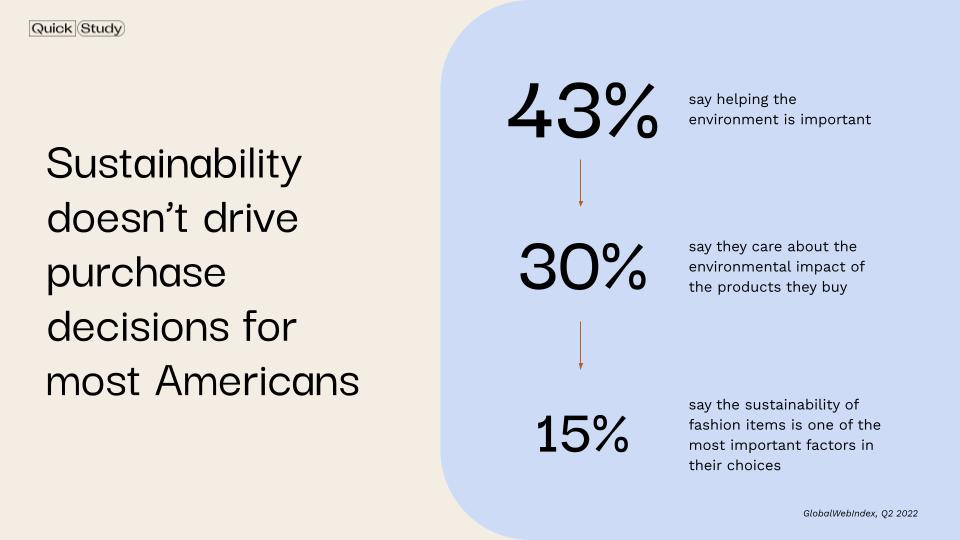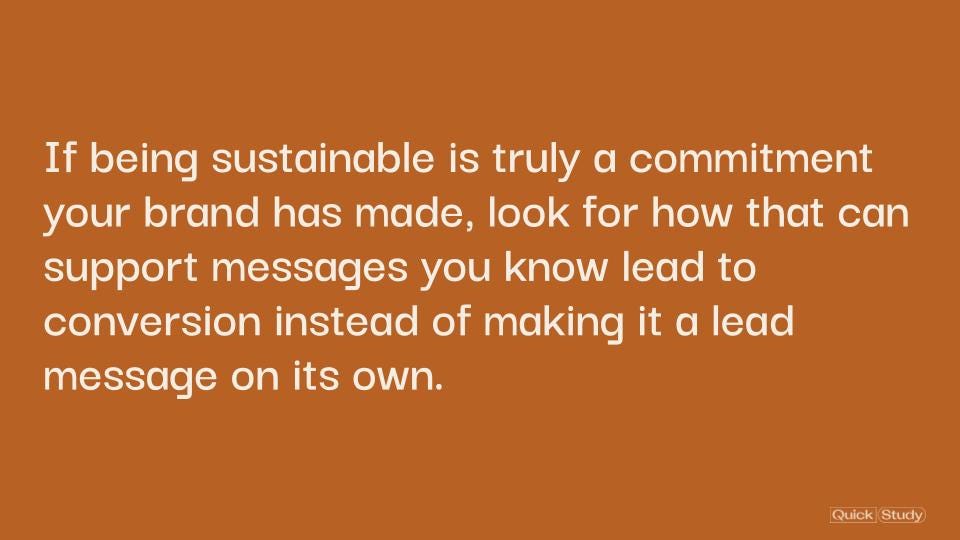What secondhand can signal: A new way to look at sustainability messaging for brands
A Study Guide from Quick Study
Hi. Hey. Hello. This is The Other 90, a blog about strategy from your friends at Quick Study. Global CEOs are saying Quick Study “moves at light speed without compromising on research and quality” and that we are “the real deal—the kind of team you want in your corner for all the big, gnarly, complex ‘how are we ever going to solve this?’ problems.”
If this is your first time, welcome! Feel free to check out the archive. You can also view this post on our website.
Let’s start here:
For most brands, the message of sustainability is a supporting one, not a converting one. That may sound harsh, but it’s a reality I’ve seen play out for many clients over the last few years, especially those in fashion & apparel. It may even feel counterintuitive considering how much brands push sustainability in their messaging, but that’s actually part of the problem.
In short, the mass use of sustainability language means that its power as a unique message point for brands has become completely watered down & generally substance-less. To help illustrate how far-reaching sustainability is as an umbrella, here are just a few conversations around sustainability (or lack thereof) lately: a collection of state governors are going after ESG investors; Shein, the fast-fashion behemoth and most downloaded shopping app in the US, moves into popup retail; a Kardashian became the “sustainable ambassador” for a different fast fashion brand; the credibility of F1’s sustainability pledges have come into question from one of its own drivers; and the White House called for crypto mining standards that help lower its environmental impact. The sustainability conversation has become so prevalent that it’s at times muddy, confusing, misleading, and/or overwhelming, and consumers either don’t know what to believe anymore, just assume brands are doing their best to be more sustainable, or are turned off by the conversation altogether.
The evidence isn’t just anecdotal; consumer research helps spell out how difficult it is to take a concern for the environment and turn it into a converting message for brands right now, especially when it gets down to personal decision making. Starting broadly the numbers aren’t so bad: GlobalWebIndex’s Q2 2022 survey of Americans 16+ found that 60% try to recycle as much as possible, 50% want the government to do more to help the environment, and 43% said that helping the environment is important to them.1
But when consumers are asked to put their money where their mouth is, the challenge of conversion becomes quite clear: only 35% say a brand being eco-friendly will make them more likely to purchase from them, and only 30% say they care about the environmental impact of the products they buy when compared to other purchase drivers.
Finally, when fashion enters the conversation the results are even more ominous: only 17% said knowing the product/company is environmentally friendly is an online purchase driver, 15% said sustainability is one of the most important factors when buying new clothes or shoes, and 11% said eco-friendly delivery is important when shopping online.
I admit that these numbers do feel a bit doom and gloom when it comes to people caring about the environment enough to change their purchase behaviors. But! An important caveat to remember: we don’t live in a monoculture, and not all consumers are the same. These stats do tell us that there is a segment of the population that is indeed willing to put sustainability on a pedestal when it comes to the brands they buy from, and that audience is clearly being served by the number of brands that are trying to make headlines with their sustainability stories.
For the purposes of today though, let’s focus on the other folks who aren’t being swayed. What is it that they value more than sustainability when buying clothes? The answers are fairly obvious: things like fit/comfort, price, quality, style, “looking good”, and purchasing from a brand you already know are all considered more important than sustainability when buying new clothes. (That’s why when advising Gap on their sustainable denim messaging I always told them the only “good” that matters is when a customer asks how their butt looks in the jeans.)
So we’ve learned that sustainability for sustainability’s sake doesn’t make for a winning message with most consumers right now. BUT! (Another one.) There are ways to use more subtle sustainable language to express other key differentiators for your brand. In fact, there’s a lot more sustainability conversation out there than you may realize, mostly because it isn’t necessarily being branded that way. For instance, what if we shifted our sustainability storytelling from a product’s pre-purchase journey to its post-purchase lifespan?
The power of vintage & thrifting in general fashion conversations is massive right now, but adoption is still yet to hit critical mass. In 2021, the size of the “recommerce” market was approximately $160 billion, and that number is expected to grow to $245 billion by 2025. 23% of Americans in Q2 2022 said they are comfortable buying pre-owned items rather than new ones, and while that’s only a quarter of Americans, it is up 3% over the last 2 years and fairly consistent across age groups. There are more and more influencers exclusively focusing on following sustainable shopping & fashion practices by creating hashtags like #OOOTD (Old Outfit of the Day), which will help continue to normalize this consumer behavior and push it toward the mainstream in the coming months and years.
On its face, consumers buying something your brand produced secondhand on Depop or the RealReal may not immediately benefit your specific bottom line or read as “sustainability”, but it does project a certain image about your products and how they are made. Those things that mattered more than sustainability to consumers buying clothes? Descriptions on secondhand sites are full of them. Discussions around quality, style, durability, longevity - your product consistently showing up in secondhand spaces tells consumers a lot about who you are, the product you produce, and the values you held while producing it, whether you embrace that conversation or not. (For a look at how brands have embraced this conversation, check out Patagonia, Gucci, The North Face, Lululemon, Oscar de la Renta’s work with Christie’s to auction vintage runway fashion, or even yesterday’s news that Balenciaga is launching a re-sell program after a successful pilot.)
Let’s look at a recent Quick Study project as an example of how to harness a sustainable message that is unique to your story. Our client NAKEDCASHMERE was positioned in the middle of the cashmere category - its price point is generally higher than you’ll find at an Everlane or NAADAM, but lower than luxury brands playing in the space. From a quality perspective, they can compete with luxury, and their product will far outlast the cashmere that comes cheaper. And like most cashmere brands, NAKEDCASHMERE is produced sustainably and has a powerful production story to tell. But where’s the role for sustainability when everyone else in cashmere talks about it too?
We learned through a custom study of the brand’s focus consumer that price, care, and style are major perception barriers around cashmere. Consumers think cashmere costs too much, or that it’s too hard to care for, or it’s too hard to style / there aren’t enough variations of styles. But on the flip side, a simple search showed us hundreds of NAKEDCASHMERE items on the secondhand market with positive commentary around its longevity, durability, and timeless styling. It was as if the mere existence of the secondhand market was proof that the biggest perception barriers were unfounded: it’s worth paying more because it lasts longer than you think; high-quality cashmere is durable and versatile, making care less complex; and focusing on timeless styles over fads & trends means you can keep wearing the product for seasons to come.
In the end we saw a unique opportunity to reframe the sustainability story away from the production of cashmere where everyone else is and toward the product’s long & useful life ahead, which ultimately more directly attacks the barriers to entry consumers feel. By expressing how long the product can last & how versatile it can be season to season, NAKEDCASHMERE will still be able to tell a sustainable story, just a much more subtle one that better addresses those barriers and doesn’t fall into the same word salad as so many others.
I started this piece by saying that for most brands, the message of sustainability is a supporting one, not a converting one, but perhaps it would be better to call sustainability a foundational message that supports converting ones when applied correctly. If being sustainable is truly a commitment your brand has made, look for how that can support messages you know lead to conversion instead of making it a lead message on its own - make it more about the tangible benefits sustainability has for your consumer than just proclaiming sustainable practices exist. And if you get stuck, look to how consumers talk about you for inspiration and guidance. It’s often a lot easier to hear the truth from someone else than from ourselves.
The Other 90 is written by me, Rob Engelsman, a former baby model and now Cofounder & Strategy Partner at Quick Study. To get us involved in solving your problems, email rob@quick.study. You can also find me on Twitter, Instagram, & LinkedIn.
Any statistics unsourced in the remainder of this piece are also from this GlobalWebIndex data set.






